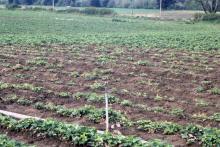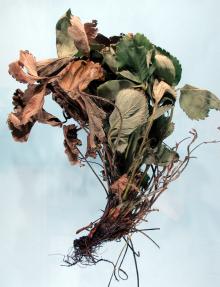Cause Verticillium dahliae, a soilborne fungus that can live many years in soil. The fungus grows into the xylem where it colonizes the plant through mycelial growth and conidial production. Fluid movement in the xylem passively transports the conidia. Once in the xylem, this fungus partially blocks water movement and produces toxins that result in wilt symptoms. Isolates that can attack strawberry have a wide host range, so it is not advisable to plant strawberry after solanaceous (potato family) or small fruit crops that have shown evidence of the disease. Many cultivars derived from resistant clones of Fragaria chiloensis, F. virginiana, and F. virginiana subsp. glauca are resistant to strains of Verticillium. California evaluations have found that the cultivars such as Rikas, Monarch, Eclipse and Mojo are resistant but it is not known if these are suitable for use in the PNW. Many of these cultivars resistant to Verticillium wilt may be susceptible to other soil borne diseases such as charcoal rot.
Symptoms Individual plants wilt, sometimes in patches in the field. It is often confused with other root and crown rots, winter injury, and tomato ringspot virus infection in cultivars such as Olympus. Plants are most severely affected in their first year.
Older leaves wilt and tend to curl up along the midvein. Inner (younger) leaves tend to remain green although stunted. Plants often are stunted, dry, and flattened with small yellowish leaves, especially as fruit ripens. Brownish streaks occur in vascular tissue of crown roots or at the base of the petiole.
Cultural control
- Plant only healthy, certified berry stock from nurseries or other plantings known to be free of wilt.
- The fungus may persist many years in soil and can attack susceptible plants' roots whenever they are placed in infested ground. Rotating to nonsusceptible grasses and cereals may lower the amount of Verticillium in infested soil but seldom eliminates it. Rotations of 5 to 8 years have been tried, though Verticillium often survives longer in soil. Rotations with broccoli and/or Brussels sprouts followed by incorporation of the crop residue for 2 years prior to planting strawberry resulted in reduced disease incidence in California.
- Anaerobic Soil Disinfestation may be helpful even in the PNW. First rice bran is incorporated into the soil followed by irrigation to near field capacity. Then place clear oxygen impermeable plastic (such as anti-condensation film) on the prepared ground. This summer treatment needs to reach soil temperatures of 90F. Use in combination with other techniques.
- Remove infected plants and the plants on either side to stop wilt spread. Do not replant where infection occurred.
- Do not track soil from infested areas into clean areas. Clean boots, equipment, and tools before leaving an infested area.
- Avoid rotations with other susceptible crops, which may increase Verticillium in the soil. Susceptible crops include potato, tomato, caneberries, eggplant, and pepper; also maple among other nursery trees, and many common weeds.
- Use resistant cultivars.
Chemical control Preplant fumigation.
- Telone C-17 at 27 to 41 gal/A broadcast on mineral soils. Allow 2 to 3 weeks between application and planting or until odor leaves soil. Do not treat extremely heavy soils. 5-day reentry. Restricted-use pesticide.
- Vapam HL at 37.5 to 75 gal/A. Immediately roll the soil and follow up with tarps or a light watering. May use through an irrigation system. 5-day reentry. Restricted-use pesticide.
Note: Research in California and Florida has not identified any nonfumigant chemicals or microbial based products that provide consistently effective control of strawberry root diseases.
Reference Holmes, G. J., Mansouripour, S. M., and Hewavitharana, S. S., 2020. Strawberries at the Crossroads: Management of Soilborne Diseases in California Without Methyl Bromide. Phytopathology, 110:956-968.




